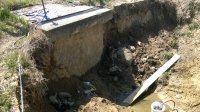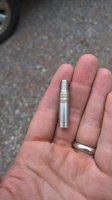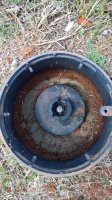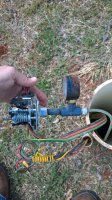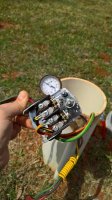Correct me if I'm wrong, if that in well tank fails, the pressure switch would be to far away from the other tank at the house. The in well tank has to be pulled to get where you can put the precharge back into tank if the bladder isn't bad and why I don't like the in well tank because it should be easy access to maintenance your system in the future.
Actually the reason for having to access the Schrader valve through the discharge pipe of the tank is so the bladder cannot lose air and doesn't need any maintenance. The bladder in the Inwell tank, including the Schrader valve, is completely surronded by water. If the pre-charge is 35# and you always keep the system pressurized like between 40 and 60, there is always more water pressure trying to get in the bladder than there is air pressure trying to get out of the bladder. So you cannot lose any air.
These tanks can only lose there air when they are sitting on the shelf in a box, or any time before you get it installed and pressured up. It is important to check the air before installation, and keep the system turned on and pressured up.
The only way these tanks can lose air is when the bladder gets a hole in it. This is one of the drawbacks of the inwell tank. The bladder is going to tear sooner or latter. Because of the vertical installation and long skinny bladder, the bladder is filled fromo the bottom up, and drains from the top down. It looks like a snake swallowing a rat. The rippling effect on the bladder creates a tear or hole in it after a certain number of cycles. Just like any captive air tank, the design and material of the bag or diaphragm determines how many cycles the bladder can take before it fails. There is just more survace area of the bag moving in the inwell tank, so it doesn't last as long as a diaphragm tank where the travel is limited.
With a CSV you really don't need any larger than a 4.5 gallon size tank to take care of the pump and system. But when used with an inwell tank, a larger tank in the house would reduce the pressure and number of cycles on the Inwell tank, and make it last longer. So I would use a 44 or 86 gallon tank at the house along with the inwell tank in the well.
You can use one of those freeze proof in well control pressure switches attached to the pitless or pipe above the inwell tank. Put the CSV just below the inwell tank, and use as short of a nipple as possible between the tank and the pitless. The further down the tank is, the more pressure it works at and the less water it holds.
With the pitless at 5', a 3' nipple below the pitless, an 8' inwell tank, and then a CSV the bottom could be 16-18' below surface. Most people use a CSV12560-1, which is a 60 PSI Cycle Stop Valve below the tank. Because the CSV is 16'-18' below surface, you will see it working at about 52 PSI on the ground. So you can still use a 40/60 switch at the top. And when you add a larger tank at the house, you may need to reduce the pressure switch setting to something like 35/55 to keep the CSV from taking too long to fill the big tank. So the larger the extra tank and the lower you set the pressure switch, the lower the pressure on the inwell tank. When you run 35/55 on the surface, the inwell tank is working at about 43/63 because it is down in the well 16'.
Don't mean to make it sound complicated because it isn't. There are just a few more things to consider when setting up an inwell tank system, but they work fine.
Some areas are just too deep to bury tanks, or people just don't want to dig that big of a hole. So the inwell has some uses. But if you do bury a diaphragm tank like the Amtrol, the top 2/3rds of the tank is air, so you don't have to bury the whole tank that deep.



